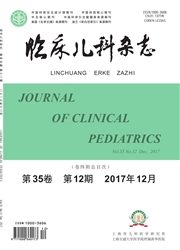

 中文摘要:
中文摘要:
目的探讨影响足月新生儿早发型及晚发型坏死性小肠结肠炎(NEC)发病及预后的相关因素。方法回顾分析1996年至2015年收治的253例足月NEC病例,NEC按照发病时间不同分为早发型(≤7天发病,n=150)及晚发型(〉7 天发病,n=103),比较两组围产期情况、合并症、并发症等。结果 早发型组平均胎龄大于晚发型组(39.2±1.2 对 38.8±1.11),早发型组Ⅲ期NEC患病率(27.3% 对12.6%)、腹膜炎(20.7% 对8.7%)比例均高于晚发型组,差异有统计 学意义(P均〈0.05)。 早发型组NECⅢ期手术治疗率、总病死率与晚发型组比较,差异无统计学意义(P均〉0.05)。早发型 组中,病死患儿Ⅲ期、腹膜炎、败血症、呼吸衰竭、肾功能损害、休克、多器官功能障碍比例均高于存活患儿;晚发型组中, 病死患儿Ⅲ期NEC、腹膜炎、败血症、呼吸衰竭、休克比例均高于存活患儿,差异有统计学意义(P均〈0.05)。Logistic回归分析发现,早发型组预后不良的危险因素为腹膜炎(OR=17.49,95%CI:5.89-51.93, P〈0.001)及肾功能损害(OR=10.33,95%CI:2.7-154.17,P=0.003);晚发型组为腹膜炎(OR=20.58,95%CI:3.62-116.85,P=0.001)及呼吸衰竭(OR=12.03,95%CI:1.33-109.14, P=0.027)。 结论足月儿早发型NEC病情较晚发型更重;腹膜炎、肾衰竭是导致足月早发型NEC 患儿预后不良的危险因素,腹膜炎、呼吸衰竭则是导致晚发型NEC患儿预后不良的危险因素。
 英文摘要:
英文摘要:
Objective To explore the relevant factors that impacted the morbidity and prognosis of early-onset and late-onset necrotizing enterocolitis (NEC) in full-term infants. Methods A total of 253 full-term infants with NEC hospitalized during 1996 to 2015 were retrospectively analyzed. They were divided into early onset group (onset within one week of birth, n=150) and late onset group (onset after one week of birth, n=103) according to their onset time. The perinatal conditions, co-conditions and complications between two groups were compared. Results The average gestational age of the early onset group was older than that of late onset group (39.2±1.2 vs. 38.8±1.1), and the morbidity of NEC III stage (27.3% vs.12.6%) and peritonitis (20.7% vs.8.7%) were higher in early onset group than those in late onset group. The differences were statistically significant (P all〉0.05). In the early onset group, the proportion of deceased infants with NEC III stage, peritonitis, septicemia, respiratory failure, renal dysfunction, shock, and multi-organ functional disturbance in infants died finally were higher than those survived. In the late onset group, the proportion of infants with NEC III stage, peritonitis, septicemia, respiratory failure, renal dysfunction, and shock in infants died finally were higher than survived infants. The differences were statistically significant (P all〉0.05). Logistic regression analysis showed that the risk factors of poor prognosis in early onset group were peritonitis (OR=17.49, 95% CI: 5.89-51.93, P〈0.001) and renal dysfunction (OR=10.33, 95% CI: 2.7-154.17, P=0.003), while those in late onset group were peritonitis (OR=20.58, 95% CI: 3.62-116.85, P=0.001) and respiratory failure (OR=12.03, 95% CI: 1.33-109.14, P=0.027). Conclusions The condition of early-onset NEC was more severe than that in late-onset NEC in full-term infants. In addition, in full-term infants, peritonitis and renal dysfunction were risk factors of poor prognosi
 同期刊论文项目
同期刊论文项目
 同项目期刊论文
同项目期刊论文
 期刊信息
期刊信息
